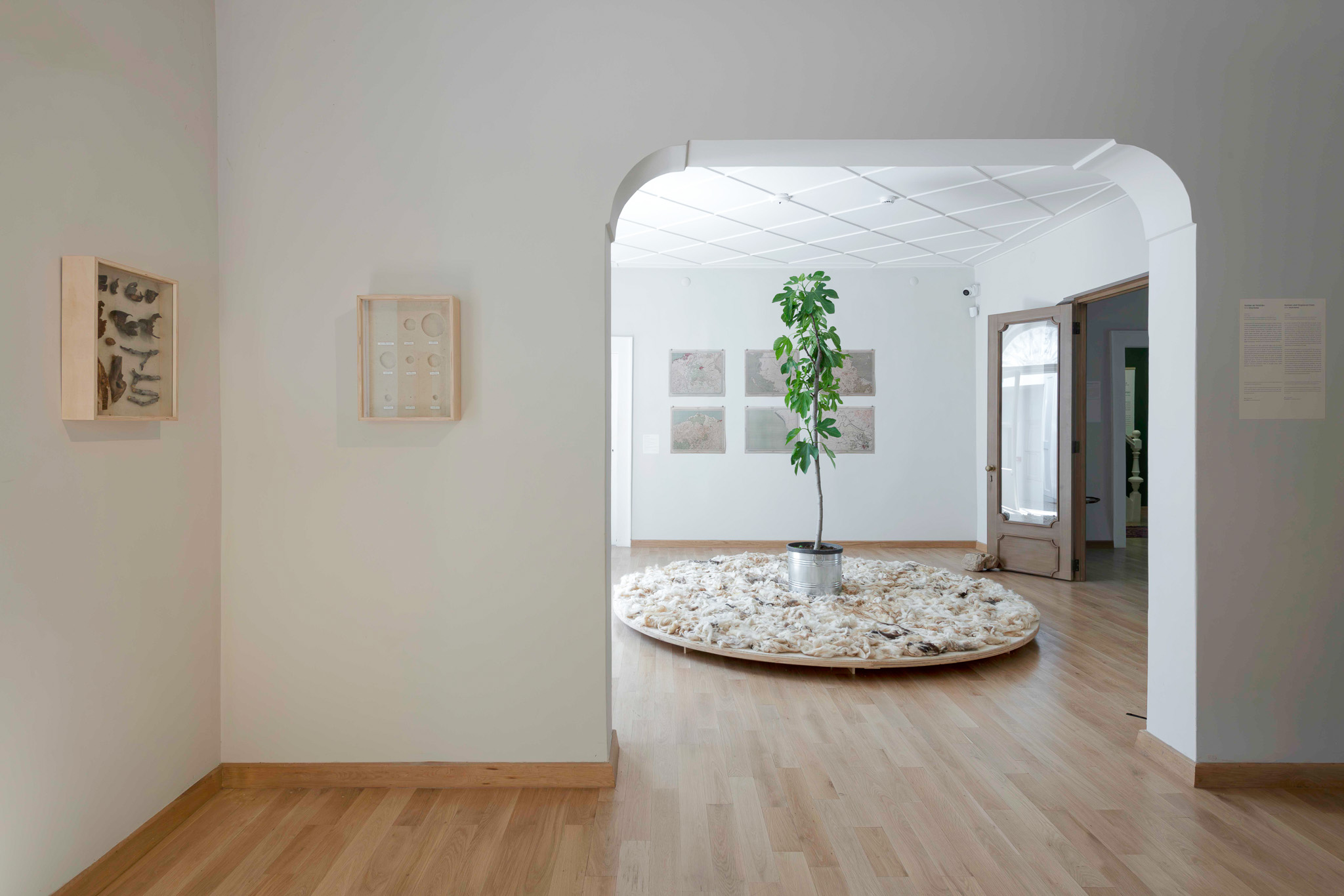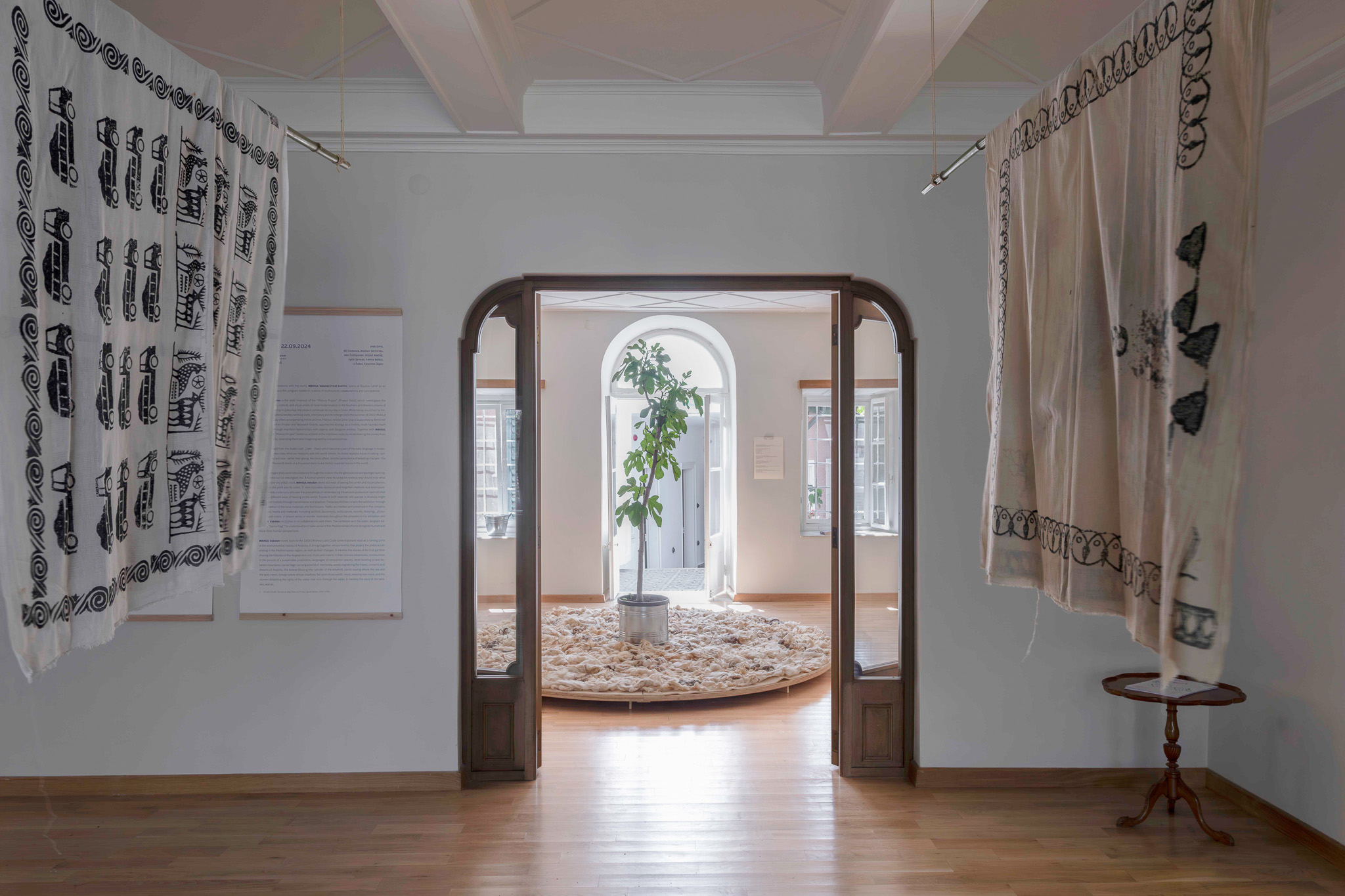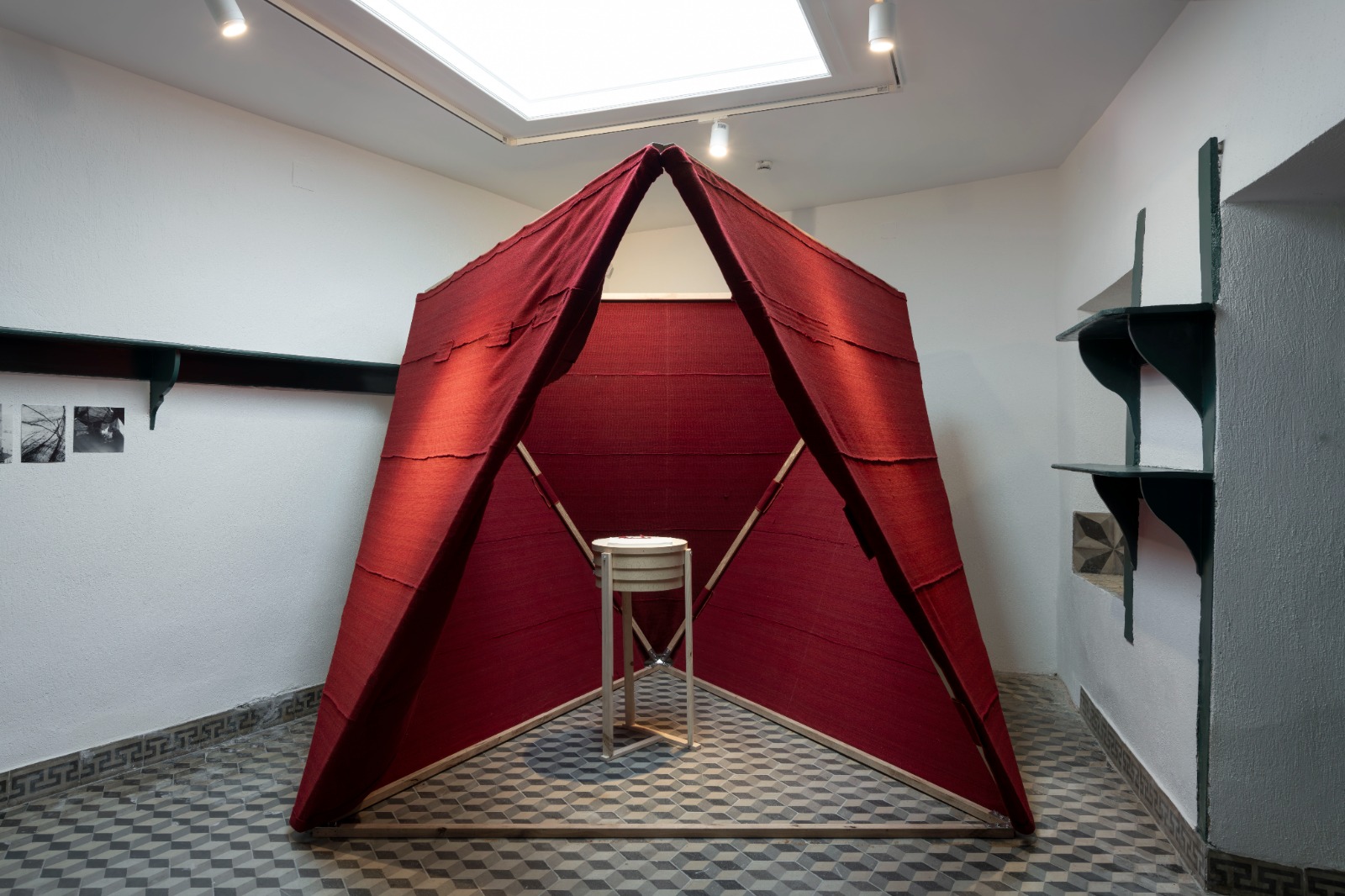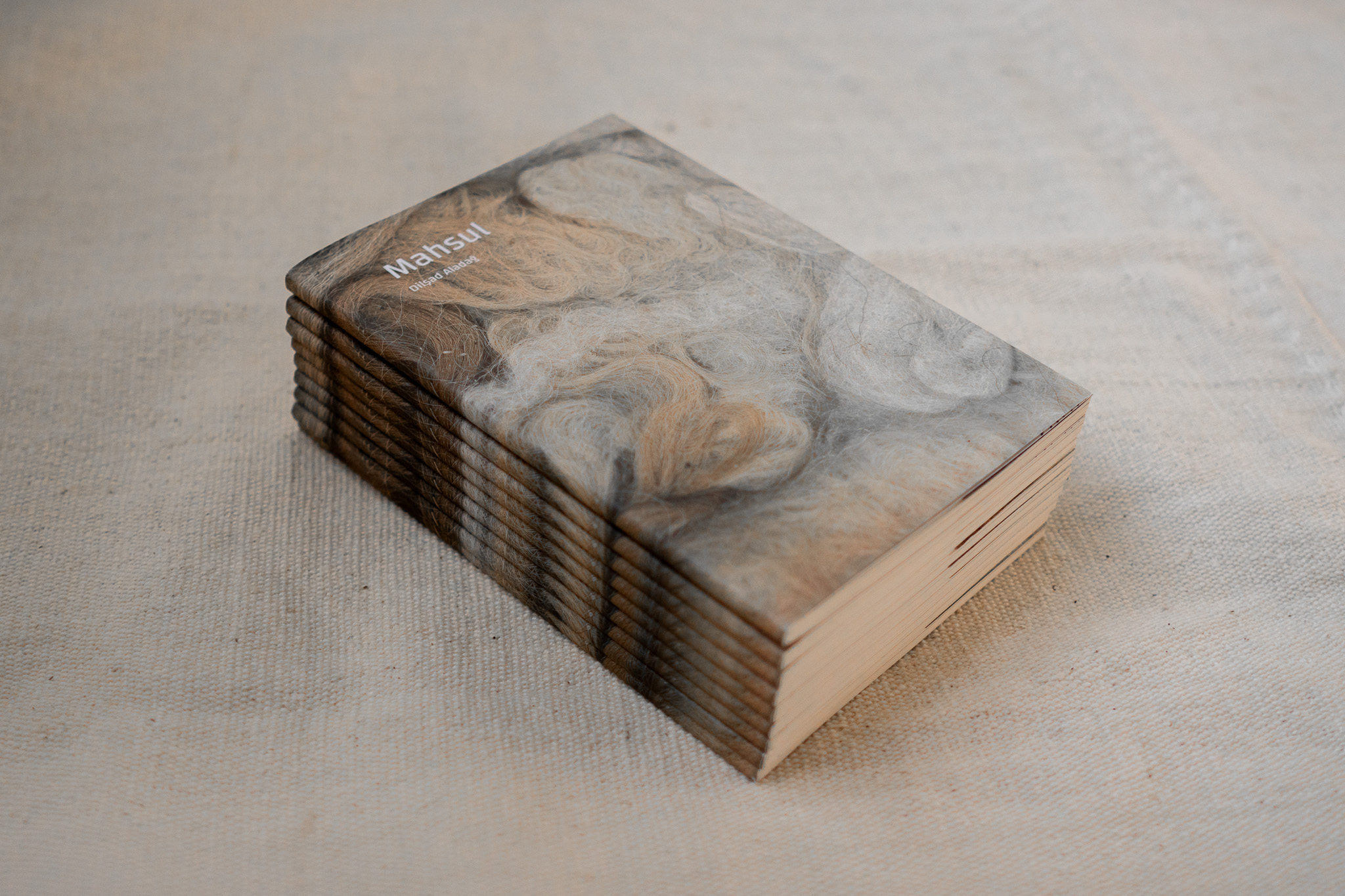Mahsul Vakaları / Yield Events
Research, exhibiton and public programs / Curating / Bayetav Sanat











General views from the exhibition, Photos: Kayhan Kaygusuz

Dünya ile kurulan ilişkilere dair tarifleri yeniden ele alan Mahsul Vakaları, işbirlikleri ve bir aradalıklara dayalı bir sergi ve kamu programı olarak Bayetav Sanat’ta gerçekleşiyor.
Mahsul Vakaları, Çukurova’da başlayan ve İzmir’de devam eden, Anadolu’nun güney ve batı kıyılarındaki kırsal modernleşme sürecinin çevresel, kültürel ve toplumsal mahsullerini araştıran Mahsul Projesi’nin bir mahsulü. 2022 yazından bu yana süren, coğrafya gezileri, arşiv ziyaretleri, görüşmeler ve kayıtlarla beslenen araştırma, eş zamanlı olarak genişleyen çevrimiçi bir arşiv denemesi de sunuyor. İzmir ayağı BAYETAV Bir Arada Yaşarız Destek Programı ile desteklenen Mahsul Projesi,
ekolojiyi türler arası ilişkilerle kenetlenen çok katmanlı ve devingen bir ağ olarak ele alıyor. Mahsul Vakaları ile bugünün devinimlerini coğrafyadan hikâyelerle hatırlayarak, yeniden seslendirerek ve türler arası birliktelikler hayal ederek düşünmeyi öneriyor.
Sergi ve kamu programı, dünyayı benzer meraklarla mesken tutan üretimleri yankılarken onlarla işbirliği yaparak çoğalıyor, toprağın, suyun ve havanın hikâyelerini buluşturuyor. Dilşad Aladağ’ın araştırma sürecinden süzülenler ile birlikte ANATOPIA, Ali Cindoruk, Aslıhan Demirtaş, Aslı Özdoyuran, Eylül Şenses, Fatma Belkıs & İz Öztat, Yasemin Ülgen’in üretimleri sergi kurgusunu oluşturuyor.
Serginin kavramsal çerçevesini oluşturan Mahsul Projesi araştırma süreci 2022 ve 2023 yılında CultureCIVIC: Kültür Sanat Destek Programı kapsamında Avrupa Birliğinin desteğiyle üretilmiştir.
Readdressing relations with the world, Mahsul Vakaları [Yield Events], opens at Bayetav Sanat as an exhibition and a public program based on a series of multispecies collaborations and comraderies.
Mahsul Vakaları is the yield (mahsul) of the Mahsul Projesi [Project Yield], which investigates the environmental, cultural, and social yields of rural modernisation in the Southern and Western shores of Anatolia. Starting in Çukurova, the project continues its journey in İzmir. While being nourished by forays to geographical locales, archival visits, interviews and recordings since the summer of 2022, Mahsul simultaneously offers an expanding online archive. Mahsul, whose İzmir stop is supported by BAYETAV Research Fellowship, approaches ecology as a mobile, multi-layered mesh connected through manifold relationships with organic and inorganic entities. Together with Mahsul Vakaları, the Mahsul Projesi invites us to think of the mobilities today by remembering the stories from this geography, reiterating them and imagining earthly companionships.
A shared sense of wonder resonates throughout the artworks in this exhibition and Mahsul Vakaları multiplies in its collaborations with them and meshes the story of the land, sea, and air. The works of ANATOPIA, Ali Cindoruk, Aslıhan Demirtaş, Aslı Özdoyuran, Eylül Şenses, Fatma Belkıs & İz Öztat, Yasemin Ülgen, together with the yields of Dilşad Aladağ's research process constitute the narrative of the exhibition.
Yield Events research process, which forms the conceptual framework of the exhibition, was produced in 2022 and 2023 within the scope of CultureCIVIC: Culture and Arts Support Programme.
Basın kiti için tıklayınız - link for the press kit in Turkish
Selected Reviews
Ömer Mirza Şeker, Anadolu Ajansı 2024
Kadim Üretim Yöntemlerini Hatırlatan Bir Sergi, Vesime Itır Demir, Hürriyet 2024
Emine Uyar, Evrensel 2024
Natives and Displaced Ones
Artistic research, installation / İzmir / Bayetav Sanat
The project is developed within the scope of the Mahsul [Yield] Project and exhibited at Mahsul Vakaları - Yield Events exhibition.
Artistic research, installation / İzmir / Bayetav Sanat
The project is developed within the scope of the Mahsul [Yield] Project and exhibited at Mahsul Vakaları - Yield Events exhibition.





Installation.
Wooden plinth and a fig tree sapling, 270 x 270 x 150 cm.
Found and produced objects, frame, 30 x 40 x 5,5 cm (6 pieces)
Sound, 5’ 45”, Syrian Woodpecker-Dendrocopos syriacus.
As humans transform the uncultivated and unclaimed 'mevat' lands into gardens and orchards, İzmir evolves into an important connecting port in the trade network carrying the fruits of Western Anatolia to Europe. Centuries pass, hunts and hunters, natives and displaced ones change. While the birds of this harbor fly into exile, the woodworms of distant ecologies reach this harbor. Finding the strength to mature and settling in the hollow of the tree, the worm cultivates its own gardens on the tree. In the absence of the bird, the tree that feeds the worm's belly cannot nourish itself or humans anymore. The gardens turn into landscapes of struggle.




The Natives and Displaced Ones is a current station of the research of the same title that explores the entangled stories of the Fig Tree, the Woodpecker, the Woodworm, and Human that have left traces along the Mediterranean coasts. The installation originates from the Land Law of 1858, which can be considered as a turning point in the environmental history of the geography covered by the Ottoman Empire. Assembling a multispecies narrative, Natives and Displaced Ones installation opens up questions about ownership, care, and satisfaction in humanity's relationship with the land. As a part of the installation, a spatial intervention questions the scale and the ownership of the land that is occupied to feed and settle. A video installation and cabinets of curiosities hosting the traces of species of this entangled story completes this intervention.
Natives and Displaced Ones installation is produced with the support of BAYETAV. The research process was supported by CultureCIVIC, a project by the European Union, which included consultancy support from Meriç Öner.
Natives and Displaced Ones hosts the book Seeds of Power by Onur İnal and Yavuz Köse, which compiles various studies on Ottoman environmental history. Maps from 1925 depicting various districts of Izmir, selected from the SALT Research Collection, accompany the installation.
Photo credits: Kayhun Kaygusuz
Mahsul
Printed publication / Published by BAYETAV, İzmir
Printed publication / Published by BAYETAV, İzmir

Mahsul, printed publication in Turkish, 72 pages, 1000 copy
Research and texts Dilşad Aladağ
Graphic design Mahsul [Yield] Project
Editor Merve Şen
Publisher BAYETAV
Print Sena Ofset
‘’Mahsul, Akdeniz’de izini sürdüğüm, ancak Anadolu’nun da kürenin de farklı noktalarında benzer şekillerde yankılanarak yeni yolculukları başlatabilecek açık uçlu bir merak. 2022’de başlayan ve iki yılda dallanıp budaklanan süreç çokça karşılaşmayı beraberinde getirdi, Mahsul’ün heybesi doldu taştı. Heybede birikenlerin kimi birbiriyle kendi başına eklemlenmeye başladı kimiyse heybeye fikriyle, merakıyla ve duygusuyla misafir olan üretimlerle işbirliğinde çoğalarak dahil oldu. Bu bağ noktalarında, mahsullerle kesişen, toprağın, suyun ve havanın hikâyelerini buluşturan, türler arasındaki örüntüleri hayal eden Mahsul Vakaları bir sergi ve kamu programı olarak ortaya çıktı.’’







︎︎︎ Bayetav Sanat ile iletişime geçerek temin edilebilir.
A Fictive Dialogue on Dunes
Artistic research, lecture performance and installation / İzmir / Bayetav Sanat
The project is developed within the scope of the Mahsul Vakaları and Shorelines projects.
Artistic research, lecture performance and installation / İzmir / Bayetav Sanat
The project is developed within the scope of the Mahsul Vakaları and Shorelines projects.

The lecture-performance, titled Identification of the Dune, Invention of the Coast, is based on Professor İbrahim Atay’s book Identification and Afforestation Technique of Dunes published in 1972. It begins with an intergenerational dialogue between the performer and the author through his voice memos, exploring the contrasts between the perspectives of the identifier and the reclaimer, companion seeds, and architectural interventions. This fictive dialogue takes past studies conducted on the Mediterranean coasts into account and aims to ignite discussions on the practices that lay the groundwork for the transformation of Turkey’s coasts. The installation, A Fictive Dialogue on Dunes, invites the viewers to experience the performance space containing the presentation-performance recording, research outputs and observation tools.


Photos from the exhibition: Kayhan Kaygusuz
A Fictive Dialogue on Dunes, 2024
Dilşad Aladağ
Video, site-specific installation
Performance recording, 47’ 00” (loop),
Archive file containing drawings, sand and plant samples, texts, overhead projector and magnifying lamp, 150 x 50 x 120 cm
Text: İbrahim Atay, Kumulların Tesbiti ve Ağaçlandırılması Tekniği, İstanbul Üniversitesi Orman Fakültesi, Kurtulmuş Matbaası, İstanbul, 1972
Voices: Erdem Şenocak, Dilşad Aladağ
Performance recording and editing: Sezer Koç ve Burak Çevik
Sound Design: Postgarden
"Identification of the Dune, Invention of the Coast” research was supported by CultureCIVIC, a project by the European Union, which included consultancy support from Meriç Öner.. The lecture performance, which was developed as part of the "Shorelines” research conducted by Meriç Öner, is supported by the British Council’s Creative Collaborations Grant Programme.
Identification of the Dunes, Invention of the Coast
Artistic research and lecture performance / İstanbul / AVTO
The project is developed within the scope of the Mahsul and Shorelines projects.
Artistic research and lecture performance / İstanbul / AVTO
The project is developed within the scope of the Mahsul and Shorelines projects.



In the 20th century, rural areas of Anatolia underwent a transformation into sites for research and development in modernization projects. One of the responsibilities assigned to foresters in this field was the identification and reclamation of active coastal sand dunes. Professor İbrahim Atay aimed to stabilize the “active” dunes, which he believed would cause “myriad and very significant damages,” through landscape interventions that became increasingly prevalent in the latter half of the 20th century. State narratives depicted the dunes as either a hard-to-handle monster or a barren desert where not even a blade of grass would grow. During this period, thousands of hectares of sand dune areas on the Anatolian shores were reclaimed with seeds from distant lands and through imported architectural interventions. Despite being arguably viable solutions by then, the landscape and plants had a shared fate in terms of displacement. Originally devised for and belonging to elsewhere they were not quite fitting into the natural setting but the project went on regardless. Ultimately, the monster was tamed, and the desert was rejuvenated to a state where it could yield crops. The identification of the dunes also paved the way for the invention of the coast. Initially, a new nature emerged, followed by the development of agricultural fields on the coasts, and the subsequent rise of holiday resorts.


Architect and researcher Dilşad Aladağ’s lecture-performance, titled “Identification of the Dune, Invention of the Coast,” is based on Professor İbrahim Atay’s book “Identification and Afforestation Technique of Dunes,” published in 1972. It will begin with an intergenerational dialogue between the performer and the author through his voice memos, exploring the contrasts between the perspectives of identifier and reclaimer, companion seeds, and architectural interventions. This fictive dialogue will take past studies conducted on the Mediterranean coasts into account and aim to ignite discussions on the practices that lay the groundwork for the transformation of Turkey’s coasts.
Images: Screenshots from performance shot made by Doğa Yirik, AVTO on 21.12.2023
Reference: İbrahim Atay, Identification and Afforestation Technique of Dunes, Istanbul University Faculty of Forestry, Kurtulmuş Printing House, Istanbul, 1972.
Developed as part of the research Shorelines, “Identification of the Dune, Invention of the Coast” is supported by the British Council’s Creative Collaborations Grant Programme.



Essay & Talk:
A Fictive Dialogue on Coastal Dunes
09.03.2024, Performance Ecologies Program curated by Eylem Ejder
We are delighted to have two special guest speakers this Saturday (2.30pm-4pm, GMT+3) to talk about performance lectures. Theatre scholar and performance artist Clio Unger is joining us with her talk titled "Consuming Art/Consuming Knowledge?" to be followed by architect and researcher Dilşad Aladağ’s presentation titled "A Fictive Dialogue on Coastal Dunes".
The talk "A Fictive Dialogue on Coastal Dunes" is about Dilşad Aladağ's lecture performance and research process titled "Identification of the Dune, Invention of the Coast" which was developed within the scope of the Mahsul and Shorelines projects. It explores the methodological potentials of a fictive dialogue as a performative research and lecture experience.